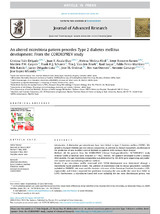An altered microbiota pattern precedes Type 2 diabetes mellitus development: From the CORDIOPREV study
Autor
Vals-Delgado, Cristina
Alcalá-Diaz, Juan F.
Molina-Abril, Helena
Roncero-Ramos, Irene
Caspers, Martien P.M.
Schuren, Frank H.J.
Broek, Tim J. Van den
Luque, Raúl M.
Pérez-Martínez, Pablo
Katsiki, Niki
Delgado-Lista, Javier
Ordovas, José M.
Ommene, Ben van
Camargo García, A.
López-Miranda, José
Editor
ElsevierFecha
2021Materia
Intestinal microbiotaType 2 diabetes mellitus
Predictive model
Coronary heart disease
CORDIOPREV
METS:
Mostrar el registro METSPREMIS:
Mostrar el registro PREMISMetadatos
Mostrar el registro completo del ítemResumen
Introduction. A distinctive gut microbiome have been linked to type 2 diabetes mellitus (T2DM). We aimed to evaluate whether gut microbiota composition, in addition to clinical biomarkers, could improve the prediction of new incident cases of diabetes in patients with coronary heart disease. Methods All the patients from the CORDIOPREV (Clinical Trials.gov.Identifier: NCT00924937) study without T2DM at baseline were included (n = 462). Overall, 107 patients developed it after a median of 60 months. The gut microbiota composition was determined by 16S rRNA gene sequencing and predictive models were created using hold-out method. Results. A gut microbiota profile associated with T2DM development was determined through a microbiome-based predictive model. The addition of microbiome data to clinical parameters (variables included in FINDRISC risk score and the diabetes risk score of the American Diabetes Association, HDL, triglycerides and HbA1c) improved the prediction increasing the area under the curve from 0.632 to 0.946. Furthermore, a microbiome-based risk score including the ten most discriminant genera, was associated with the probability of develop T2DM. Conclusión. These results suggest that a microbiota profile is associated to the T2DM development. An integrate predictive model of microbiome and clinical data that can improve the prediction of T2DM is also proposed, if is validated in independent populations to prevent this disease.

